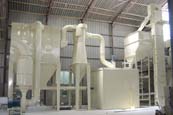معلومات ذات صله

استشر الولايات المتحدة
بصفتنا مصنعًا عالميًا رائدًا لمعدات التكسير والطحن ، فإننا نقدم حلولًا متطورة وعقلانية لأي متطلبات لتقليل الحجم ، بما في ذلك إنتاج المحاجر والركام والطحن ومحطة تكسير الحجارة الكاملة. نقوم أيضًا بتوريد الكسارات والمطاحن الفردية وكذلك قطع غيارها.






Chromium processing | Extraction, Uses & Applications
Ores Although chromium occurs in many minerals, the only ore exploited commercially is chromiteThis spinel mineral is ideally composed of ferrous oxide and chromic oxide with the chemical composition FeO · Cr 2 O 3,2014年11月17日· Chromite ore processing residue (COPR) is a waste byproduct of chromate production that contains high levels of hexavalent(PDF) A Review of Chromite Ore Processing Residue
Leaching of hexavalent chromium from young chromite
2020年3月18日· 32 Chromite ore processing residue leaching behavior Figures 1 and 2 show the results of the COPR leaching as a function of2023年1月1日· Considering the tailing disposal problems of chromite gravity concentration plants, the research works of Amer and lbrahim (1996) on hydrometallurgicalChromite ore beneficiation: prospects and challenges
Processing of LowGrade Chromite Ore for Ferroalloy
2020年7月14日· The lowgrade siliceous chromite ore from Ghutrigaon, Odisha, India, containing ~ 16% Cr2O3, with Cr/Fe ratio of 197 and ~ 55% of SiO2, does not find any2011年4月1日· Since most chromite ores are easily beneficiated with gravity concentration methods, flotation of chromite has not been widely applied or got commercialChrome ore beneficiation challenges & opportunities – A
Process optimization of a chrome ore gravity
This approach has not only resulted in the reduction of chrome losses (<12% Cr 2 O 3) but also the concentrator achieved a stringent target SiO 2 grade of 327% in the concentrate The approach adopted and practical2020年7月5日· 1 Introduction Chromite Ore Processing Residue (COPR) is a solid waste generated during the high temperature (∼1200 °C) roasting process that is used toMicrostructural analyses of Cr(VI) speciation in chromite
A cleaner method for preparation of chromium oxide from chromite
2017年1月1日· Its chromite ore processing residue (COPR) includes carcinogenic and mutagenic calcium chromate (CaCrO4), which is a significant source of pollution to the2016年6月1日· Suresh (2016) Processing of Ferruginous Chromite Ore by Dry HighIntensity Magnetic Separation, Mineral Processing and Extractive Metallurgy Review, 37:3, 196210, DOI: 101080/2016HighIntensity Magnetic Separation Processing of Ferruginous Chromite
Identification of Cr(VI) speciation in ferrous sulfatereduced chromite
2019年7月5日· Chromite ore processing residue (COPR) is an industrial waste generated during the extraction of Cr(VI) from chromite ore using the hightemperature limebased roasting process [[1], [2], [3]] When COPR undergoes weathering reactions during the deposition process, it would release highly toxic and mobile Cr(VI) due to the2020年3月18日· 32 Chromite ore processing residue leaching behavior Figures 1 and 2 show the results of the COPR leaching as a function of the number of PV exchanged (dimensionless time) Aqueous concentrationsLeaching of hexavalent chromium from young
Microstructural analyses of Cr(VI) speciation in chromite ore
2020年7月5日· 1 Introduction Chromite Ore Processing Residue (COPR) is a solid waste generated during the high temperature (∼1200 °C) roasting process that is used to extract chromium from chromite ore (Antony et al, 2006)Limebased roasting has been the prevalent method to complex other metals in ore (Fe, Mg, Al) and isolate CrKeywords: Ultrafine chromite tailings, Magnetic separation, Characterization, Chromite 1 Introduction Chromite recoveries is a major concern particularly in processing of finely disseminated ores due to its inherent complexities The gravity separation process is the main beneficiation process used to recover chromite mineral However,Beneficiation of South African chromite tailings using Avestia
Ecological and human health risk assessment of chromite ore processing
2022年7月1日· In this study, ecological and human health risk assessment (HHRA) of the subsurface environment was performed due to the presence of six different contaminants, ie, Cr(VI), U, F, As, NO 3, and Mo, in the proximity of chromite ore processing residue (COPR) dumping sites of Northern India The analysis covered a probabilistic riskof chrome ore that is produced in South Africa is exported for smelting into ferrochrome which is then processed into stainless steel8 Zimbabwe Zimbabwe is historically the second largest location for chromite reserves, accounting for approximately 12 percent of the global chromite reserves Zimbabwe chrome ore productionKPMG commodity insights bulletin chromite
Impact of brownmillerite hydration on Cr(VI) sequestration in chromite
Impact of brownmillerite hydration on Cr(VI) sequestration in chromite ore processing residue 289 24 Mineralogical Characterization of the COPR Sample The initial COPR sample was homogenized and air dried for 24 hours Two grams of the homogenized air dried sample was pulverized by a McCrone micromill for 10 min together with 7 mL2020年9月9日· chromite ore processing residue (rCOPR) and impacts of environmental factors erosion on Cr(VI) leaching J Hazard Mater 2019, 373, 389Different Pathways for Cr(III) Oxidation: Implications for Cr(VI
Environmental status of groundwater affected by chromite ore processing
2016年11月23日· Chromite ore processing residue (COPR) is generated by the roasting of chromite ores for the extraction of chromium Leaching of carcinogenic hexavalent chromium (Cr(VI)) from COPR dumpsites and contamination of groundwater is a key environmental risk The objective of the study was to evaluate Cr(VI) contamination inFtmmachinery Shaking Table can be used for roughing, concentration, and sweeping to separate coarse sand (205 mm), fine sand (050074 mm), sludge (within 0074 mm), and other different particle sizes It is veryShaking Table In Ore Processing | Fote Machinery
Case Study: Chromite mining and processing Public Health
Case Study: Chromite mining and health concerns 5 Chromium mining and processing In nature, chromium is found as chromite ore, composed of elemental iron, oxygen and chromium (FeOCr 2 O 3) 1,2 heavily in about a 700 m vicinity around the Countries with commercially significant chromite mines include Russia, South Africa, Zimbabwe,2021年1月23日· Odisha state is the major reserve of the chromite ore Due to the extensive applications, highgrade chromite ore is getting depleted day by day Now it is a challenge for the industry to utilize these lowgrade ores and tailings Several attempts were taken to upgrade the lowgrade chrome ores and tailings using different gravitySelective Flocculation of Chromite Tailings | SpringerLink
Efficient reduction of Cr(VI) and recovery of Fe from chromite ore
2023年5月1日· Chromite ore processing residue (COPR) is a byproduct generated after the leaching of sodium chromate by roasting chromite ore at 1200 °C However, the residual 1130–8500 mg/kg of highly toxic Cr(VI) in COPR poses a severe threat to the ecosystems ( Du and Chrysochoou, 2018 , Xia et al, 2020 , Molinari et al, 2021 , Guleria2020年7月14日· The lowgrade siliceous chromite ore from Ghutrigaon, Odisha, India, containing ~ 16% Cr2O3, with Cr/Fe ratio of 197 and ~ 55% of SiO2, does not find any use in metallurgical industry and hence considered as waste Mineralogical investigation indicates the presence of chromite and quartz as major minerals with minor fuchsite andProcessing of LowGrade Chromite Ore for Ferroalloy
Processing of Chromite Overburden by Soda Roasting to Recover
2021年6月17日· Sukinda overburden is dumped with chromite ore tailing which contains about 17% Cr2O3 The other constituent with overburden is iron, silica and alumina Because of its complex nature and large amount of gangue material it is not suitable for the extraction of valuable chromium by conventional route The author of the present2021年6月3日· The South African platinum industry has advanced into an era of predominantly mining and processing Upper Group Two (UG2) ore to extract Platinum Group Metals (PGMs) Flotation concentrates derived from processing UG2 ore are typically characterized by high chrome contents (>3 wt%) which are not amenable toThe Reduction of Chrome in UG2 Flotation Concentrate by
Treatment of hexavalent chromium in chromite ore processing PubMed
2005年8月15日· We investigated a method for delivering ferrous iron into the subsurface to enhance chemical reduction of Cr(VI) in chromite ore processing solid waste (COPSW) derived from the production of ferrochrome alloy The COPSW is characterized by high pH (85115) and high Cr(VI) concentrations in the sol2021年9月15日· Chromite ore processing tailing, a solid waste generated during the processing of chromite ore, is difficult to recover due to its ultrafine size The tailings generated from the process contains valuable chromite and ironbearing minerals, loss of which is a matter of concern for the ferrochrome industry worldwideEfficient utilization of nickel rich Chromite Ore Processing
A cleaner method for preparation of chromium oxide from chromite
2017年1月1日· Its chromite ore processing residue (COPR) includes carcinogenic and mutagenic calcium chromate (CaCrO4), which is a significant source of pollution to the ecological environment and health of mankind (Zhao et al, 2017) Hence, the limebased roasting process has been eliminated in 2013